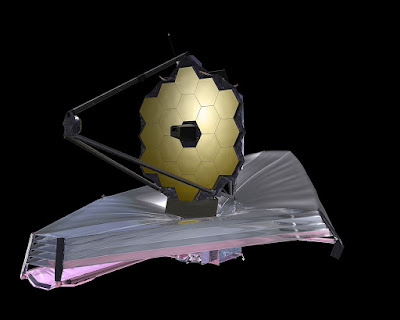James Webb Space Telescope - update
The Hubble Space Telescope has been working now for over 20 years. Some (maybe all) of the photos it's sent back have been incredible, and the science it's produced has developed our knowledge of the cosmos considerably.
But it's also getting a little old. In 22 years, technology has marched quite a bit, meaning the instruments we put up there are not exactly cutting edge.
But second, Hubble's spectrum is limited to UV and visual frequencies. We're starting to get curious about the infrared - that is, what's going on on the other side of the visual spectrum.
The James Webb Space Telescope (JWT) is nearing completion, and is due to be launched in October this year. This telescope is intended to complement and replace Hubble.

The telescope itself is large. Its mirror has a "sort-of diameter" of 6.5 metres, but it's not circular, Rather, it's an array of 18 hexagon-shaped mirrors, 1.32 metres across. To give you an idea of the size of this monster, the ASV's largest telescope is just one metre in diameter - and the JWT is 18 of them!
Having segmented mirrors has a couple of advantages, including that it can fold itself a little to fit inside the rocket fairing. Segments can also be adjusted individually to make sure the images it captures are as good as they can be.
To give us the new science we're addicted to, the instruments on the JWT are biased towards the infrared. They can take some photos in the visual spectrum as well, but as Hubble has pretty much covered that, visual and UV were a lower priority. To help with this, the JWT mirrors are coated in a thin layer of gold, which has a higher infrared reflectivity than other coatings. I think the JWT looks like a relic off the set of "Goldfinger".

Tangentially, that's not the only movie set it looks like it's escaped from. Check out the view from below - it's right off the set of Star Wars!
The telescope is going to be located at the L2 LaGrange-point, which is about 1.5 million kilometres from Earth, directly away from the Sun. It'll be constantly in the shadow of the Earth. While this is a good place to observe from, it's a saddle point, meaning if the spacecraft deviates off the point slightly, it will fall further way. It'll need maintenance propulsion to keep it in place, meaning it has to have a fuel supply, which will limit its life.
Because of this, the JWT has a five-year mission (another movie reference?), although it could be extended another five years if the fuel lasts. So it won't be long before NASA and the ESA will be planning on a replacement. There are possibly other things that humans might devote their resources to, but I guess that's the price we pay for our insatiable curiosity.
Comments
Post a Comment